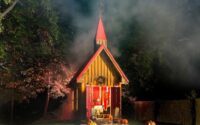For a taste of ‘The Gilded Age’ visit these stunning historic mansions
“Downton Abbey” devotees have alarms primed for Julian Fellowes’ new series “The Gilded Age,” debuting on HBO today.
This time, Fellowes’ drama is set around late 19th-century New York, a time and place when the excesses of the newly minted, self-appointed upper class of industrial and financial moguls, who built massive empires during the mid-19th century industrial revolution, was on full display in lavish retreats built with no thought of expense.
Nowhere was Gilded Age excess greater than in Newport, RI, where America’s wealthiest built grand “summer cottages” along Bellevue Avenue, which is still lined with spectacular late-1800s mansions.
In fact, the HBO series includes the Breakers, Marble House, the Elms, Rosecliff, Chateau-sur-Mer and Hunter House in various scenes.

But best off all, many of these glitzy getaways from the show are open to the public.
Undoubtedly, he Breakers, built by Cornelius Vanderbilt II, is the most splendid. Built on a plot just off Bellevue for maximum water views, The Breakers was designed for a jaw-dropping response. CV2’s guests riding up Bellevue past other mansions reached his monolithic Italianate masterpiece and knew exactly who was top cat.

The Breakers and those other Gilded Age mansions is part of the Preservation Society of Newport County’s (NewportMansions.org) collection of historic properties, and is open for daily tours, year-round.
When it comes to Gilded Age roots and current day exclusivity and luxury, the Chanler at Cliff Walk (TheChanler.com) is It. Built in 1865 for New York Congressman John Winthrop Chanler and his wife Margaret Astor Ward, famous guests included poet Henry Wadsworth Longfellow and Pres. Theodore Roosevelt.

The location on Newport’s famous Cliff Walk overlooking the Atlantic Ocean isn’t to be sniffed at, and the 20 unique rooms — the Renaissance Room has a sunken tub — are designed for full-on cosseting, including an aromatherapy bath service. Just call and a perfectly hot, fragrantly therapeutic bath is drawn at your pleasure. Room rates from $615 per night.
For another glorious Gilded Age sleepover, check into Wheatleigh (Wheatleigh.com) in Lenox, a secluded Renaissance Revival country home, built in 1893 for Manhattan real estate tycoon Henry H. Cook in western Massachusetts’s Berkshire Hills.

Listed on the National Register of Historic Places, this opulent hotel with only 19 guest rooms and suites — and no two are alike — feels like a private estate.
The French cuisine-inspired restaurant, the Portico by Jeffrey Thomson, adds to the exclusivity with only eight tables and deeply personal service. Rates from $850 per night.
Like Newport, the Berkshires was lousy with money by the late 1800s. In quaint Stockbridge, Naumkeag (TheTrustees.org) was built in 1885 as the summer residence of New York lawyer and American ambassador to the United Kingdom, Joseph Hodges Choate, and his artist wife, Caroline Dutcher Sterling Choate.

The voluptuous shingle-style house and its 8 acres of notable gardens are surrounded by 40 acres of woodlands. Naumkeag reopens in spring for the Daffodil and Tulip Festival, April 21 to May 15, and offers tours until it closes after the holiday lights event in early January.
Erie Railroad head Jay Gould, an oft-called “robber baron,” could have built any palatial manse he desired from scratch, but he fell in love with Lyndhurst (Lyndhurst.org) in Westchester County, NY, and snapped up the Tarrytown house in 1880 as his country home. Built on 67 acres, Lyndhurst is a preeminent example of American Gothic Revival architecture, utterly packed with design details, including (the fashionable at the time) faux-marble and Gothic carvings.

It has the biggest four-poster bed you’ll ever see and a whopping 7,00-square-foot bowling alley pavilion with river views, one of the first regulation lanes built in the country. Lyndhurst reopens for the season for the Lyndhurst Flower Show, April 2 to 3, and is open for tours April through December.
For all the environmental wreckage of the industrial revolution, its elite loved to get back to nature. Near remote Raquette Lake, NY, in the Adirondacks, Lake Kora (LakeKora.com) “Great Camp” was built in 1898 for Timothy Woodruff, Lieutenant Governor of New York, as an exclusive back to nature retreat.

Later, CV2’s son Alfred Gwynne Vanderbilt bought it.
Now, Lake Kora is open seasonally for exclusive buyouts for up to 35 guests with games, sports equipment, farm-to-table meals and made-to-order campfires laid on. The 16 rustic-luxe guest rooms in six separate historic structures include many original furnishings and bespoke fixtures, including stone hearths and vintage soaking tubs. Rates from $22,980 per night for 24 guests, available July through October.


